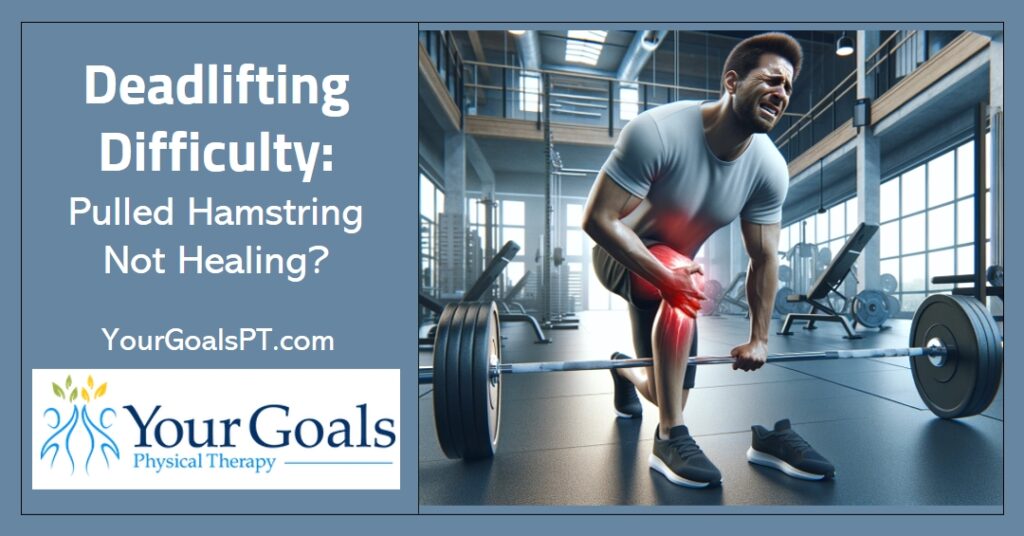
I was at a powerlifting meet a few months back. I watched a powerlifter walk up to the bar, reach down to place his hands on the bar to set himself up to deadlift. All of a sudden he popped right back up with anguish on his face as he grabbed the back of his leg. While he was still holding the back of his leg he ripped off his back brace and walked off the platform.
You don’t have to be a powerlifter to hurt your hamstring deadlift or to understand the frustration of getting hurt doing something that feels like a simple move. All he did was bend over to get set up…
The moment you feel that pain on the back of your leg a flood of emotions come in. You feel defeated, angry, and frustrated all at the same time. Then the anxiety sets in over the fear you’ve permanently hurt your leg and the idea you might not be able to lift at the level you want.
Then all these questions suddenly flood your mind:
If you’ve been working out for a while, no matter the level, it is very likely you have injured your hamstring at least once deadlifting.
Many people go to the doctor only to be told to rest it and ice, which makes going back to the doctor a second time less likely. Why would you?
Some people find someone, oftentimes a massage therapist or chiropractor, that can help with the immediate pain. Unfortunately, they then have to consistently return when the pain comes back when they pull their hamstring again. No matter how often they stretch or what strengthening exercise they try, the hamstring pull keeps coming back.
If that sounds like your story, you are not alone, I have worked with hundreds of athletes, weekend warriors and even parents that pull their hamstring who are trying to get back to their favorite activities without the annoyance and worry of re-injuring their hamstrings.
There are 5 things that you can do that will deadlift proof your hamstrings and that’s what we’re gonna talk about in this blog post.
Hi, I’m Dr. Molly with Your Goals Physical Therapy and I help active adults end their aches and pains so they can get back to deadlifting at the level they want.
Most people know that they should stretch, but don’t because it’s boring. This is no different for high level athletes or someone new to working out.
Stretching is time-consuming with no immediate payoff.
There’s also a thought that if you’re strong you’re not able to be flexible.
This is a false thought with the only caveat being depending on the muscle mass, you may lose a little range but that is not the same as not being flexible.
Now back to deadlift…if your hamstrings are tight then bending down to grab the bar can stress your hamstring putting them at a greater risk for tearing while you’re lifting.
What I mean is by placing a muscle in stretched position then asking it to maximally contract is a disaster waiting to happen.
For example: You wouldn’t stretch a rubber band to its thinnest point (i.e. stretch it all the way out) and then pull the middle back to use it as a sling shot and not expect it to snap.
This is the same idea of bending over to set up for a deadlift. If your hamstrings length is such that they are stretched to their longest length when you set up for the deadlift then that mean you are expecting them to lift from a compromise position. This set up can lead to an injury whether you are lifting a pen off the floor or 1000 pounds.
So make time to stretch…
No I’m not talking about just strengthening your lower back.
Most people think that deadlifting is only a lower back exercise.
Yes, your lower back muscle does work during a deadlift; however, it should help as a spine stabilizer not as the main mover.
Deadlifting is a glut and abs dominant activity.
Therefore you should make sure you are increasing your abdominal glut strength. But don’t stop with just those two body parts.
The Deadlift is full body exercise.
Your upper back is key to maintaining control of the bar, not to mention trunk stability.
Your feet stabilize your knees and prevent you from losing power as you drive the weight up.
So make time lots of core and whole body strengthening.
One of the most common reasons for hamstring injury is hip and lower back instability.
The way instability causes a hamstring pull is…. The primary function of ligaments is to hold joints together. If a ligament becomes stretched or is overpowered and is no longer able to stabilize a joint then the muscles around the joint take over as joint stabilizers.
It is easy to assume that because you are stable walking around that you would also be stable lifting heavy weights.
However, if the little endurance muscles and ligaments in your lower back, pelvis, and hips are not strengthening along with the big power muscle eventually these smaller stabilizers cannot do their job of keeping your bones together as you lift.
What that would look like in relation to deadlifts and hamstrings is….
if the lower back and hips joints shift causing the bone you sit on, or ischium, to move backward. The sudden stretch on the hamstring triggers your hamstring to tighten (or spasm) in order to protect the pelvis and itself from a traumatic injury.
The good news is that like strength, stability can be improved.
Examples of stabilizing exercises for deadlifting would be single leg and/ or balance activities.
Don’t just train on 2 legs see what each leg does on its own.
Learning and practicing proper deadlift mechanics is important, with light or no weight.
Your body wants to do what you ask it to do therefore when you have a goal to lift heavier and heavier weight often proper form is compromised in a small way.
When you have no pain, to the change in mechanics then your body will keep this new way of moving.
Unfortunately, you will hit a breaking point. You will hit a number of reps or a weight that your body can’t simply overcome by a simple form adjustment. This is the point where your hamstrings are now over stretched or over worked to the point of pain.
By taking time to practice the deadlift form without weight you can ensure that you will maintain proper form as you progress your weight. By slowing down and moving throughout the full range without the stress of the weight you can then feel when your muscles activate or get tight.
This allows you to alter your training to get the best results.
Work with a physical therapist that specializes in educating and training deadlift mechanics.
Deadlifts are an amazing functional movement whether you are simply trying to improve your overall health or lift impressive weight. However, they require you to use muscles in ways that are contrary to our modern life.
The exercise is full of motions that require pelvic stability that throughout our day we get from our chairs, couches and cars. It requires full extension of your upper back, hips, and knees which is the opposite of our posture using technology (phone, computers, watching TV.)
I point this out to show how unnatural completing a deadlift is, so it makes sense that you would have difficulty figuring out how to correct your deadlift form and stopping your hamstring from pulling.
—
Some of these may seem intuitive and some of them may seem far-fetched. I get that I often have to show people on their own anatomy, how this all plays together, but this is what I do all day.
I help active adults deadlift at the level they want. I’ve studied what normal motion looks like, which allows me to tease out what abnormal motion is to then we correct that movement helping my clients achieve their goals. It is very complicated to try to diagnose all of these things by yourself.
You’ve seen through this article how several joints and muscles have to work together to achieve and maintain proper form. It’s very hard to diagnose and correct problems like this through online videos or reading blogs. Even blogs as amazing as this one.
This is where working with a professional is helpful. They take away all the anxiety and cut through all the confusion, to create a clear and concise treatment plan to get you back to Deadlifting without worrying about re-injuring your hamstring. And in many cases, my clients are able to lift heavier weights than they were before working with me.
If this is the type of care you are looking for and you are ready to start now, feel free to click the button below that says “Ask about cost & availability”, you will fill out a quick form and I will call you back to answer your questions.
If you have already tried working with a professional, and you didn’t get the results you were looking for, and you are skeptical that working with me would be any different, I offer a Free Discovery Session. This is a 20 minute session where you can ask questions about your injury and how I can help. This gives you time to meet me face to face and we can make sure we are a good fit for each other.
We help active adults end their aches and pain, so they can reclaim their favorite recreational activities and live life to the fullest.

MEDICAL DISCLAIMER:
All information on this website is intended for instruction and informational purposes only. The authors are not responsible for any harm or injury that may result. Significant injury risk is possible if you do not follow due diligence and seek suitable professional advice about your injury. No guarantees of specific results are expressly made or implied on this website.